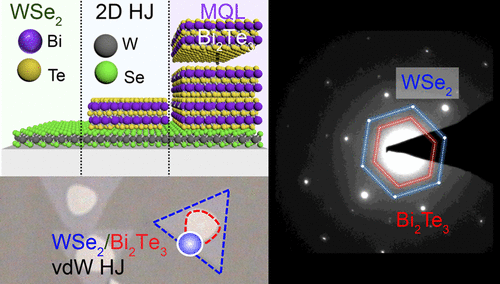当前位置:
X-MOL 学术
›
ACS Mater. Lett.
›
论文详情
Our official English website, www.x-mol.net, welcomes your
feedback! (Note: you will need to create a separate account there.)
Epitaxial Growth and Determination of Band Alignment of Bi2Te3–WSe2 Vertical van der Waals Heterojunctions
ACS Materials Letters ( IF 9.6 ) Pub Date : 2020-09-14 , DOI: 10.1021/acsmaterialslett.0c00254 Chih-Wen Yang, Hao-Ling Tang, Shahid Sattar, Ming-Hui Chiu, Yi Wan, Chia-Hao Chen, Jing Kong, Kuo-Wei Huang, Lain-Jong Li, Vincent Tung
ACS Materials Letters ( IF 9.6 ) Pub Date : 2020-09-14 , DOI: 10.1021/acsmaterialslett.0c00254 Chih-Wen Yang, Hao-Ling Tang, Shahid Sattar, Ming-Hui Chiu, Yi Wan, Chia-Hao Chen, Jing Kong, Kuo-Wei Huang, Lain-Jong Li, Vincent Tung

|
Artificial heterojunctions formed by vertical stacking of dissimilar two-dimensional (2D) transition metal dichalcogenide (TMD) monolayer materials in a chosen sequence hold tantalizing prospects for futuristic atomically thin circuits. The emergence of 2D topological insulators (TI), including Bi2Te3, Bi2Se3, and Sb2Te3, represents a new class of 2D building blocks and can complement the existing artificial heterojunctions as a result of their intriguing surface states protected by the time-reversal symmetry. However, the determination of band alignments of such 2D TI/TMD vertical heterojunctions, the key parameter for designing HJ-based electronic/photonic devices, which lies in the development of epitaxy growth, remains in its infancy. Here, we demonstrate the epitaxy growth of 2D TI/TMD vertical heterojunctions comprised of Bi2Te3/WSe2 with atomically clean interfaces that are spectroscopically accessible, and theoretically tractable. Cross-sectional scanning transmission electron microscopy (STEM) images and the presence of interlayer-coupled characteristics from Raman spectroscopy collectively confirm the neat stacking of Bi2Te3/WSe2 with the absence of unwanted containments. Microbeam X-ray photoelectron spectroscopy (μXPS) measurement coupled with the density functional theory (DFT) calculations and electrical characteristics of field effect transistors quantitatively reveals the type-II alignment of vertically stacked of quintuple layers (QL) Bi2Te3/WSe2. Meanwhile, the type-III band emerges when transitioning to multi-quintuple layer (MQL) Bi2Te3/WSe2. The finding here provides a well-defined example of the epitaxy growth paradigm, the interlayer coupling-electronic properties relationship, for these emerging 2D TI/TMDs vertical heterojunctions.
中文翻译:

Bi 2 Te 3 -WSe 2垂直范德华异质结的外延生长和能带取向的确定
通过以选定的顺序垂直堆叠不同的二维(2D)过渡金属二卤化双金属(TMD)单层材料形成的人工异质结具有诱人的未来原子薄电路前景。包括Bi 2 Te 3,Bi 2 Se 3和Sb 2 Te 3在内的二维拓扑绝缘体(TI)的出现代表一类新的2D构建基块,并且由于其时空对称性保护了其有趣的表面状态,因此可以补充现有的人工异质结。然而,这种2D TI / TMD垂直异质结的能带对准的确定仍处于起步阶段,而2D TI / TMD垂直异质结是设计基于HJ的电子/光子器件的关键参数,它位于外延生长的发展过程中。在这里,我们演示了由Bi 2 Te 3 / WSe 2组成的2D TI / TMD垂直异质结的外延生长具有原子上干净的界面,该界面在光谱上可访问,并且在理论上易于处理。横截面扫描透射电子显微镜(STEM)图像和拉曼光谱的层间耦合特征的存在共同证明了Bi 2 Te 3 / WSe 2的整齐堆叠,并且没有多余的杂质。微束X射线光电子能谱(μXPS)测量结合密度泛函理论(DFT)计算和场效应晶体管的电气特性定量地揭示了垂直堆叠的五层(QL)Bi 2 Te 3 / WSe 2的II型排列。同时,当过渡到多五重层(MQL)Bi 2 Te 3 / WSe 2时,出现了III型带。此处的发现为这些新兴的2D TI / TMD垂直异质结提供了外延生长范例的良好定义示例,即层间耦合-电子特性关系。
更新日期:2020-10-05
中文翻译:

Bi 2 Te 3 -WSe 2垂直范德华异质结的外延生长和能带取向的确定
通过以选定的顺序垂直堆叠不同的二维(2D)过渡金属二卤化双金属(TMD)单层材料形成的人工异质结具有诱人的未来原子薄电路前景。包括Bi 2 Te 3,Bi 2 Se 3和Sb 2 Te 3在内的二维拓扑绝缘体(TI)的出现代表一类新的2D构建基块,并且由于其时空对称性保护了其有趣的表面状态,因此可以补充现有的人工异质结。然而,这种2D TI / TMD垂直异质结的能带对准的确定仍处于起步阶段,而2D TI / TMD垂直异质结是设计基于HJ的电子/光子器件的关键参数,它位于外延生长的发展过程中。在这里,我们演示了由Bi 2 Te 3 / WSe 2组成的2D TI / TMD垂直异质结的外延生长具有原子上干净的界面,该界面在光谱上可访问,并且在理论上易于处理。横截面扫描透射电子显微镜(STEM)图像和拉曼光谱的层间耦合特征的存在共同证明了Bi 2 Te 3 / WSe 2的整齐堆叠,并且没有多余的杂质。微束X射线光电子能谱(μXPS)测量结合密度泛函理论(DFT)计算和场效应晶体管的电气特性定量地揭示了垂直堆叠的五层(QL)Bi 2 Te 3 / WSe 2的II型排列。同时,当过渡到多五重层(MQL)Bi 2 Te 3 / WSe 2时,出现了III型带。此处的发现为这些新兴的2D TI / TMD垂直异质结提供了外延生长范例的良好定义示例,即层间耦合-电子特性关系。











































 京公网安备 11010802027423号
京公网安备 11010802027423号